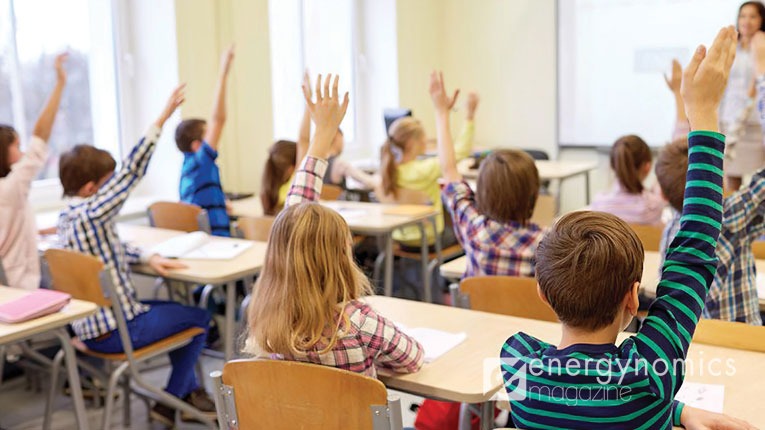Building sustainability becomes more and more a highlight for private buildings, especially office and commercial buildings, Denisa Diaconu, energy policy analyst and project manager at Energy Policy Group, told us. Public buildings can assume the role of a model, she told us, “and this can start even with schools since they capture public interest, which will increase awareness on the benefits of energy efficiency”. More about the subject in this interview, on the occasion of the start of energy renovation works at the “Elie Radu” Technological High-School of Ploiești, an initiative of Energy Policy Group (EPG), through “Efficient Romania”, the largest private project of national interest dedicated to energy efficiency in buildings.
 Why did you start actions within the “Efficient Romania” project with the efforts to renovate schools?
Why did you start actions within the “Efficient Romania” project with the efforts to renovate schools?
I would start from an extremely suggestive proverb for the role of community in the development of future generations: “It takes a village to raise a child”. Ensuring good learning conditions for children is the most important duty we have, and energy rehabilitation of schools is an essential step in this direction.
Students are the main beneficiaries of the renovation works we execute and we are talking about hundreds of students for each school.
As you know, at the end of August we started the deep energy renovation works, at nZEB standards (buildings with near-zero energy consumption), of the first school selected in this program. It’s about a building of the “Elie Radu” Energy Technological High-School of Ploiești, a building that houses both classrooms, on the ground floor, and a boarding school, on the upper floors. We want it to be the first or at least one of the first schools in Romania renovated at these standards.
The total investment estimated for the rehabilitation of this building is approximately EUR 1 million, being supported by OMV Petrom, the official sponsor of the “Efficient Romania” project. Through this renovation alone, which is a pilot project, we will create much better study conditions for about 250 students and 60 teachers.
The benefits of energy renovation of a building on occupants are numerous. Referring strictly to schools, they are related to health protection, but also increasing school performance, which in the long run will contribute to the development of society. Therefore, this is the main argument for the entire work we want to do.
How should a school properly renovated from an energy point of view look like? What are the indicators to monitor?
One of the major problems in schools is indoor air quality, so any renovation work must have as the main goal, beyond cutting energy bills, the improvement of indoor air quality. Moreover, the first thing that strikes you when you enter a classroom is the poor indoor air quality and the poor ventilation conditions, although children may not even realize this. Through the renovation works we will do in the Ploiești school we envisage the installation of performing mechanical ventilation systems, which will ensure a constant and controlled air exchange, to permanently have a controlled flow of fresh air.
We also consider the modernization of the lighting system, by replacing the existing fluorescent and incandescent lighting fixtures with some high-energy, long-life lighting fixtures provided by the sponsor Signify. The quality of light – if we refer to its intensity or color, or the amount of natural light – is another decisive parameter for the school performance of students, but also the good mood of teachers.
We are also talking about the importance of thermal comfort. Unfortunately, many schools in Romania have numerous problems related to the thermal insulation of the building and the heating system. Many children are forced to study during winter either in cold rooms or in overheated rooms because the heating system is old, inefficient and does not provide the possibility to adjust the indoor temperature so that it is set at the optimal level. During summer, the temperature in classrooms, especially those with southern exposure, exceeds by far the thermal comfort level.
We don’t even realize how important all these elements are, although they are well documented scientifically and studies are proving the impact of these elements on school performance. For example, modeling by the Buildings Performance Institute Europe (BPIE) shows that in a temperature range of 20° C to 32° C, a 1° C reduction in building temperature increases a student’s learning performance by 2.3%. Also, children’s exposure to chronic noise affects their attention, memory, reading skills and performance at the standardized national tests. On the Efficient Romania website, you will find numerous analyzes indicating the importance of healthy buildings. There is a close link between the health of buildings where we spend most of our time and many illnesses caused by the poor condition of buildings (humidity, dampness etc.). Therefore, we gain from multiple points of view by doing these renovations at modern standards. And there is a lot to work in this direction in Romania’s schools.
What are the main challenges? Are they rather related to people or institutions?
We have important ambitions with the Efficient Romania project. We don’t envisage simple enveloping, but deep renovation projects, fully aligned with the new EU standards. One of the main challenges is now given by the significant increase in building materials and the lack of implementing rules for the nZEB standard, which I believe will be published by the end of the year because they are being worked on. We must avoid the risk of “over-technologizing” through national regulations the nZEB standard, which has become mandatory since the beginning of this year for all new buildings or those that will undergo major renovations.
If we refer to the public, I believe sustained efforts are still needed, through education and awareness campaigns on energy efficiency. Energy waste is an extremely serious problem. As a country, we naturally suffer from waste and inefficiency. Therefore, a change of mentality is needed. Young people have an important role to play because they have the power to inspire the communities they are part of – families, schools, circles of friends etc. – for responsible consumption of resources.
What is the potential of replication of projects you carry out?
We are fully aware that what we propose to achieve in the schools we will renovate through the Efficient Romania project will be a role model for municipalities, which can be replicated through other funding programs, or other projects developed in public-private partnership.
On the other hand, our purpose is not to create “a technology jewelry” to which no one can have access, due to way too high technology costs. We want to obtain a realistic project, at advanced energy performance standards, but at affordable costs for local authorities in the country. I am sure there will be many similar projects, because there is interest and, especially, funding available at European and national levels. Moreover, the European Commission insists on the role of setting an example that must be assumed by the public authority in energy renovation of buildings, and we believe that schools are the best starting point for the building “renovation wave” in Romania.
No matter how generous, it is obvious that a project like “Efficient Romania” cannot solve all problems. Do you consider any formula through which you can continue/extend this type of project, but using European funding (NRRP, structural funds)?
Unfortunately, the situation in Romania regarding the condition of school buildings is not very optimistic. An analysis conducted in the second half of last year based on data from the Ministry of National Education and Scientific Research, collected through the siiir.edu.ro platform, shows that in 49% (i.e. 4,806) of the analyzed school units, at least one building used by students or teachers requires rehabilitation. Out of 11,571 school units in Romania that provided data on access to utilities, 1,874 school units (respectively 16%) do not have running water in any of the buildings belonging to that unit.
Therefore, in our country, there are still so many schools that don’t have access to basic utilities. This creates a great difference between the current renovation standards envisaged by the EU and which we want to implement through the “Efficient Romania” project and the reality in the country. So there is a fantastic amount of work.
Through the European Commission initiative named the building “Renovation Wave”, Romania will have at its disposal huge European funds intended to building renovation works, to increase their energy efficiency. There will be money, but we need vision and action, effectively absorb these funds, because they are an opportunity that cannot be missed. I believe we can smartly use them, with a long-term vision, if we begin with school buildings. Renovating schools in Romania, the benefits are huge: not only will students study in a healthier environment, conducive to school performance, but the school will also become a “workshop” in itself, which will teach them about the huge benefits of energy efficiency. This is a valuable lesson for the generation of today’s young people.
—————————————-
This interview firstly appeared in the printed edition of Energynomics Magazine, issued in September 2021.
In order to receive the printed or electronic issue of Energynomics Magazine, we encourage you to write us at office [at] energynomics.ro to include you in our distribution list. All previous editions are available HERE.

 Why did you start actions within the “Efficient Romania” project with the efforts to renovate schools?
Why did you start actions within the “Efficient Romania” project with the efforts to renovate schools?